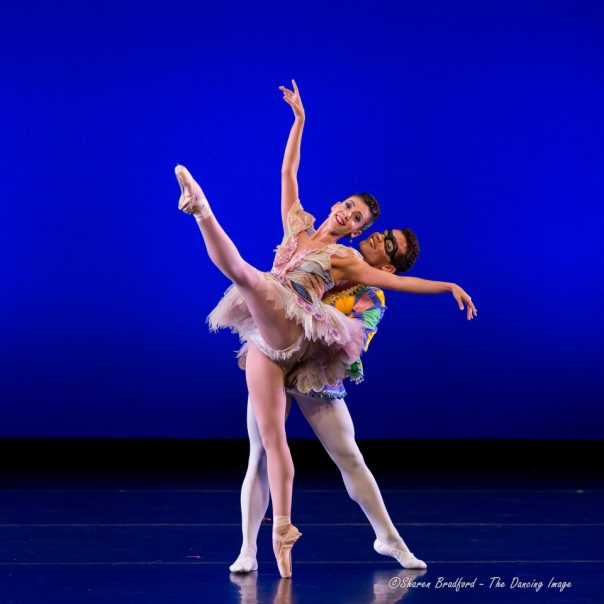Gleaming Ballet
Ballet Dallas’ Carter Alexander takes us to the gardens of Vienna in his new ballet Luisant, part of the Meadows School of the Arts’ Fall Dance Concert at SMU.

Dallas — Carter Alexander has made quite a name for himself in the Dallas dance arena since moving back to the area in 2013. His name and choreography has been attached to many local dance institutions, including Chamberlain Ballet, Contemporary Ballet Dallas (now Ballet Dallas), Booker T. Washington High School for the Performing and Visual Arts (BTWHSPVA) and the dance department at Southern Methodist University’s (SMU) Meadows School of the Arts. He was also the creator of AKA: Ballet, a collaborative project that brought local choreographers and professional dancers together for one night at the Dallas Latino Cultural Center in July 2018.
In addition to teaching and choreographing for dance schools around town, Alexander is also the co-artistic director of Ballet Dallas, a role he accepted because of his great rapport with the company. “What really drove my decision was my relationship with the dancers. They were interested in what I had to give. And that is such a wonderful thing when people are hungry for what you have to say and what your aesthetic is and they’re really hungry for that kind of relationship to work together.”
Alexanders adds, “I think that the dancers see their improvement as artists and not just technically. And I think the work that I have done there has been really good for them and I’ve brought in some interesting people for them to work with.”

Alexander’s ballet training started at his mom’s dance studio in Cheyenne, Wyoming. He then moved to Dallas to finish high school at BTWHSPVA. After graduation Alexander joined the Hartford Ballet, which is also where he first met his wife, Jeanne Elser Smith. After Hartford Ballet he joined Kansas City Ballet and also began teaching in the Kansas City Ballet School. After four years at KC Ballet Alexander moved on to Pennsylvania Ballet where his wife was also a company member.
As a ballet instructor Alexander has taught at the Ballet Workshop New England/Massachusetts Youth Ballet, the School of Ballet Arizona and the Miami City Ballet School, which at the time was under the leadership of Edward Villella.
Mostly recently Alexander was asked to set a new piece for the SMU Meadows School of the Arts’ Fall Dance Concert, which runs Nov. 13-17 at the Bob Hope Theatre on the SMU Campus. The program also includes a new work by award-winning jazz/tap artist Caleb Teicher and a revival of Robert Battle’s 2001 Battlefield.
Regarding the ballet’s title Alexander says he chose Luisant, which means “glowing” or “gleaming” in French, because he wanted to create an atmosphere where the dancers appear to shimmer as they move on stage. Alexanders says he is hoping to accomplish this glimmer affect with the aid of stage lighting and set design.
Alexander explains, “There’s going to be gray Marley flooring with white leg and there won’t be any borders at the top so you’ll see the color of the lights. You know the blues, reds and purples. So my idea is that these are colored lights in a garden and maybe in the fast movements it’s like little sprays of mist with the lights hitting the dancers giving them a glimmer affect.”
The 24-minute balletic work features 20 dancers (17 women and three men) in four sections set to Beethoven’s Symphony No. 1 in C Major. Without giving too much away Alexander says the ballet starts with the entire cast on stage before they break out into smaller groups as well as duets and solos. And sticking to classical tradition the ladies will be performing on pointe and in tutus.
As to why he chose to create a large ballet number, Alexander says, “It’s been a long time since they had a real, classical large work. I wanted to do something light, not angsty because there is something else on the program that I knew would fill that kind of role. I also wanted to give the students an opportunity to do a ballet where everybody really danced.”
Creating a large classical ballet isn’t as easy as it may appear. Alexander says one of the key things to choreographing a large ballet number is knowing how to move people around the stage. “It’s balancing when people come in and when people go out so it’s not the same the whole time. You’re giving the eye different things to look at, but you’re also giving the audience a focus.”
In Luisant, Alexander says sometimes there will be 20 people on the stage and sometimes there will be only one or two. He did this because he wanted to give audience members a lot of different looks, but notes that even though the number of dancers on stage is constantly varying, he says it’s not so fast that viewers won’t be able to see what’s happening. “It was one of my goals to make the ballet visually very pleasing. It’s a classical piece of music, but the ballet also has some jazzy parts in there as well as some contemporary movements. But it is essentially a classical ballet, which is something not a lot of people are doing now.”
He adds, “So with this piece for SMU I really wanted to give the students the opportunity to dance something very classical. But they are also wonderful in their modern and contemporary work so I wanted them to be able to relate the two and understand how the classical has all of that movement from the back and the flow through the movement, but also quick and sustained movement.”
>This preview was originally posted on TheaterJones.com.

















